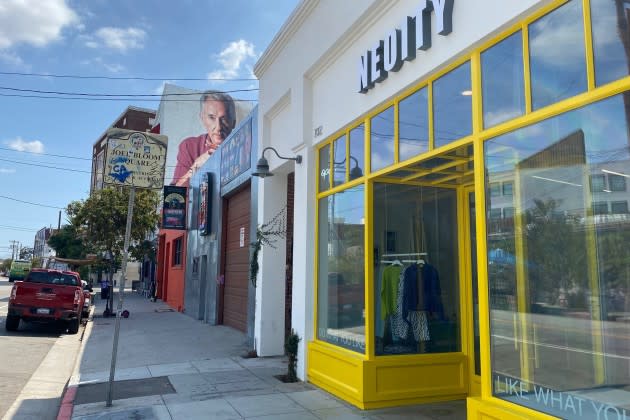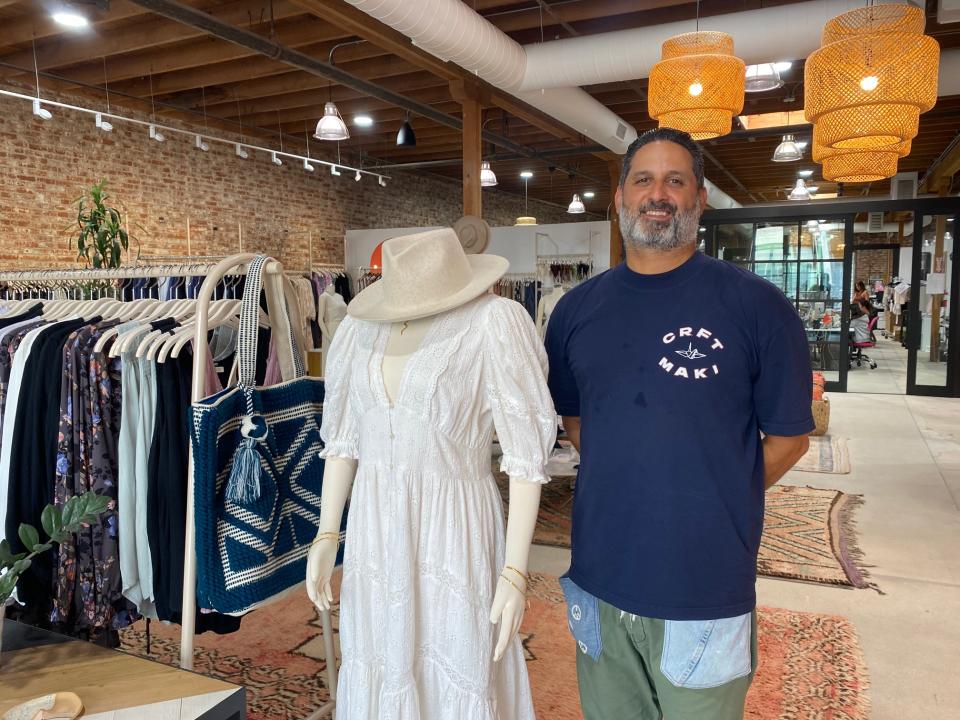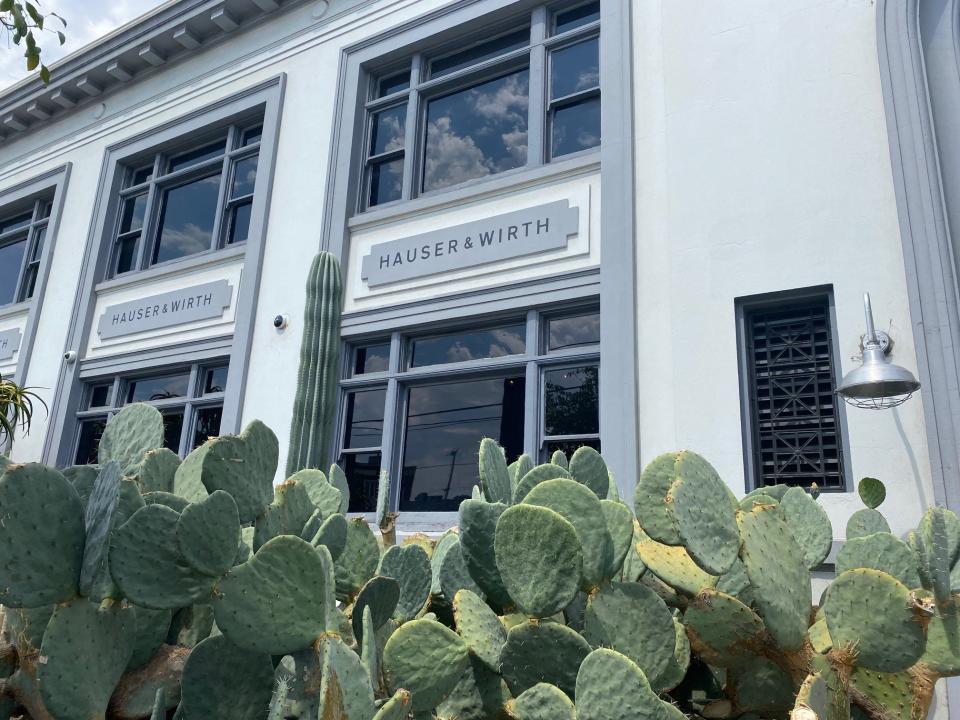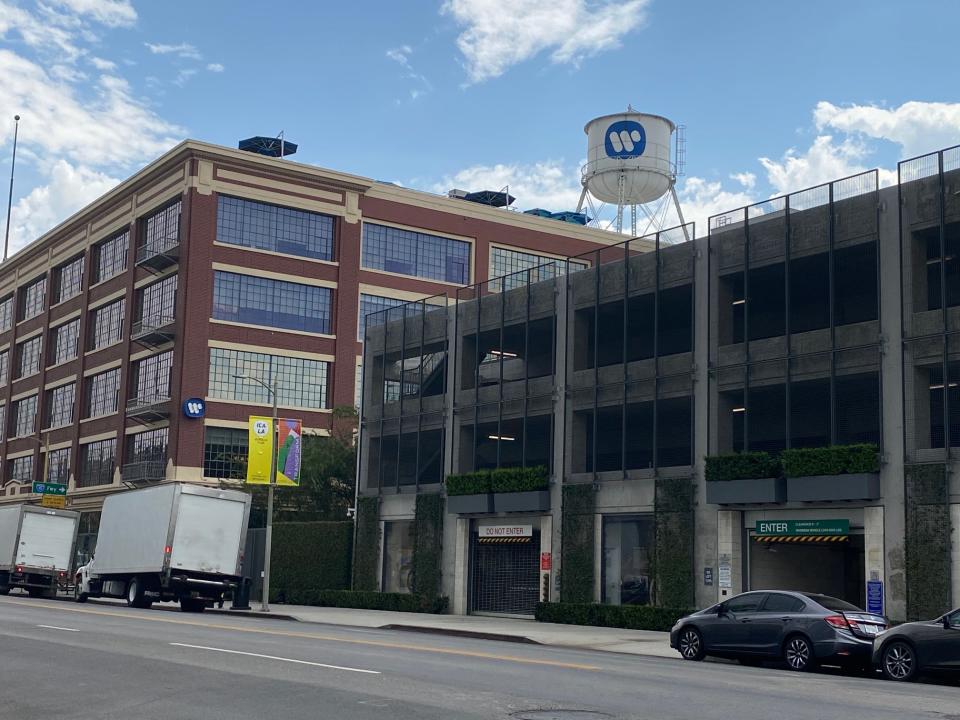Los Angeles’ Arts District Is Drawing a New Crowd of Retailers and International Fashion Companies

Danny Foruzesh, who has been making women’s boho clothing for the last 35 years as chief executive officer of Lovestitch, is fascinated with the gritty Los Angeles warehouse area called the Arts District.
Tap onto his company’s website and one will see a blog paying homage to the century-old buildings that have traveled a long journey from warehouses and factories to refurbished gems housing creative offices, design studios, art galleries, condominiums, lofts, restaurants, coffee shops and clothing stores.
More from WWD
Foruzesh adores the hip, creative and slow-paced vibe that emanates through this historic center, which started as a field planted with grapes supplying the area’s first wine, before transitioning to a railroad yard and transportation hub.
“Before the pandemic, I was in the Arts District every day for breakfast, lunch and dinner,” said Foruzesh, whose company used to be housed in a 40,000-square-foot warehouse about one mile south of the Arts District.
But when the pandemic hit in early 2020, he had to lay off some employees and downsize. When he came back up for air, he decided to act on his love for the Arts District and leased a smaller space in the artsy neighborhood — a 4,500-square-foot design studio with a 2,500 square-foot retail store in front — the company’s first brick-and-mortar outpost.
The only thing separating the two spaces is a glass wall, enabling customers to get a first-hand view of where their clothes are being created. “We wanted to have a little different experience for people coming in,” Foruzesh said.

Setting up a different experience is one of the reasons the Arts District is seeing a new influx of retail outposts and creative companies that are reexamining their office locations and shifting to appeal to their creative side.
Shein, the Chinese online fast-fashion company, is said to be interested in leasing as much as 80,000 square feet of space in the area. Shein Distribution Corp. already has 20,000 square feet of space in the Row DTLA, a mixed-use venture of rehabbed warehouses south of the Arts District.
And Vibram Corp., the Italian-based rubber shoe sole company known for its FiveFingers glove-styled shoes, is reported to be opening offices soon in an early 20th century co-work building in the Arts District. It will be near several custom shoe workshops and stores in the Arts District, including Esquivel Shoes an atelier owned by CFDA member George Esquivel, who makes no more than 4,000 custom-made shoes a year.
Another sign of major growth is that the district, with no buildings over six stories, is getting its first 35-story mixed-use structure of apartments, offices and ground-floor commercial space. With its tall cranes, the tower is rising over the neighborhood like a looming stork. More high-rises filled with apartments and offices are on the drawing board for the district.
The new apartments will house the kind of resident who likes the walkability of the district and its array of quaint coffee shops, brew pubs, offbeat stores and art galleries fronting the sidewalks. The district is a favorite spot for film crews looking for large interior spaces to use and a substitute look for New York City. On a recent afternoon, there were three film crews working in the area.
“The Arts District is this neat hub of cool creatives and small businesses,” said Michelle Hanabusa, who last year leased a 2,000-square-foot showroom and event area on Factory Place for her streetwear label Uprisers, a community-driven brand founded in 2019 to advance social change and elevate the stories of the underrepresented. Her label is carried by PacSun.
Hanabusa discovered the Arts District years ago when working for a fashion company in nearby Vernon, a grungy industrial zone to the east. “We would go to the Arts District to grab a coffee or lunch all the time because there is not much in Vernon,” she said.
During the pandemic, she moved to the Arts District and later found a vacant location across the street for her business. “There is so much inspiration around here,” she said. “It feels like a small town in a big city. Some of my production guys are right across the street. So, I can pick up samples and review them instead of driving around town.”
That small-town vibe is what drew Mari Oh to the Arts District. The founder of the clothing label Neoity, she had been selling her menswear collection of oversize T-shirts, sweatshirts, hoodies and pants since 2020 online, and later at a pop-up store on Melrose Avenue.
When business improved after the pandemic, she decided the Arts District would be a perfect space for her first permanent retail venture because her streetwear clothing attracts the kind of creative who lives in this historic patch of Los Angeles.
After occupying another space for one year in the Arts District, Neoity moved two months ago to a new retail space, part of which was once occupied by 3.1 Phillip Lim, which moved out during the pandemic.
“This area is more suitable for us, and we like the vibe here. It is more chill and relaxed,” she explained. “There are a lot of my customers living here.”
The Arts District is also home to several custom-shoe enterprises that will resole those old Air Jordan 1s or fashion a pair of made-to-order scuffs, catering to the athletic shoe frenzy that has popped up.
Rory Fortune, the cofounder of Goods & Services, first came to the Arts District in 2019, opening a tiny location for his shoe repair and custom-made footwear business.
Early this year, he moved to a more pedestrian-friendly location and tripled his space. “We’re a weird business. We are not for everybody,” he said. “But the Arts District is a good fit for us. It is creative.”
The rising coolness factor of the Arts District has not been lost on husband-and-wife team Lindsay and Raan Parton, who, with lead by their partner Paolo Carini, are opening a new retail venture next year called Free Market.
They liken it to a small department store that will encompass 40,000 square feet inside a two-story building, designed by Klein Agency, with arched windows on Traction Avenue.
The compound will be a collection of fashion, home goods and beauty boutiques mixed in with cafés, restaurants, creative offices and an event space. There are two other mixed-use Free Markets in Denver and Playa Vista, a suburb near Los Angeles International Airport.
Lindsay and her husband have a long history with the Arts District. Before the pandemic, they had two stores in the neighborhood. Parton and his brother Shea had a menswear collection called Apolis with an Arts District store. It later morphed into the Apolis Print Shop, which sold a broad collection of iconic customizable jute market bags.
In 2013, Lindsay and Raan launched a retail concept called Alchemy Works and opened a store on one of the more popular pedestrian streets in the area. Both of their locations have closed, but the Partons’ business interest in the Arts District hasn’t waned. “We really believe in this neighborhood,” said Lindsay Parton, whose Alchemy Works stores, which are a blend of home, jewelry, accessories and event spaces, have four locations around the country. Another location will open in the Free Market when it is completed.
For many years, the Arts District flew below the radar of most businesses because of the gritty nature of its streets and warehouses — some abandoned and some still operating. It abuts the Los Angeles River, a longtime popular camping spot for unhoused residents, and is not far from downtown Los Angeles and Little Tokyo.
But in the mid-’70s and ’80s, cash-strapped artists who needed affordable housing and studios began renting abandoned warehouses at rock-bottom prices. Many of the warehouses had freight elevators to reach residences and loading docks off the back, which were perfect for carting large paintings onto a truck.
Later, well-reviewed restaurants and cafés popped up, and the Arts District became a popular weekend hangout in a neighborhood likened to the Meatpacking District of New York City.
A major player in raising the district’s image was the Southern California Institute of Architecture, known as Sci-Arc. This private architectural college with an avant-garde bent moved into the former Santa Fe railroad depot in 2001, which at the time was a stripped-down concrete shell that used to receive freight trains. The school became an anchor for the district and brought in many architects whose influence can be seen all around.

One of the area’s first major art pioneers was Hauser & Wirth, an international contemporary art gallery that arrived in 2016, taking over a former flour mill and bank building. That launched major gentrification and brought in some big-name fashion companies.
In 2018, Dover Street Market, created by Comme des Garçons founder Rei Kawakubo, leased 15,000 square feet in an out-of-the-way warehouse. It attracts a fashion crowd that doesn’t flinch at the $3,000 price tags.
Not far away is the H.Lorenzo archive store in a 4,000-square-foot outpost where $3,000 items are often 50 percent off. Next door is Commonwealth, the menswear brand that opened its U.S. flagship in the Arts District in 2017.

On the creative business side, Warner Music Group moved into the century-old Ford Motor Factory three years ago, where Model Ts used to be assembled in the early 1900s. Warner Music consolidated hundreds of employees from two other offices in Southern California to the new location.
And late last year, Spotify took over a 155,000-square-foot space in the heart of the Arts District, where it has 18 soundstages, a theater, an indoor stage and soundproof listening areas.
The new influx of business is good news for Paul Witt, whose Wittmore menswear store opened seven years ago in One Santa Fe, a 478-unit apartment project nicknamed the “Empire State Building on its side” because it is 1,500 feet wide and would be higher that the New York landmark if uprighted.
Business was good before the pandemic, challenging during the pandemic and now recuperating with a 15 percent to 20 percent year-over-year increase in sales, Witt said.
“I really saw what was happening here when I signed my lease in the Arts District. It was like a cultural melting pot, in a good way,” the retailer noted. “And now it is getting a lot of attention again.”


